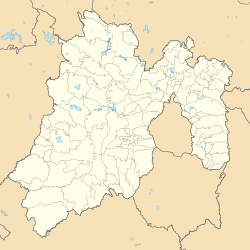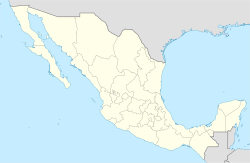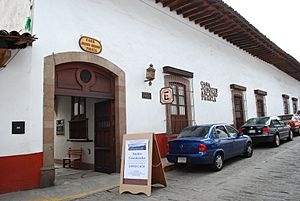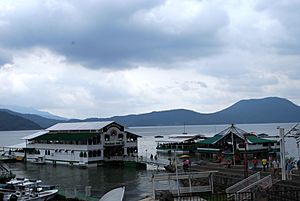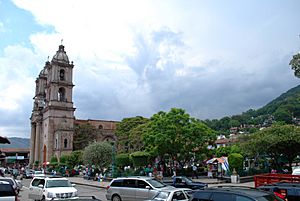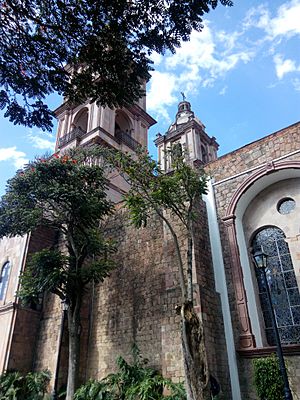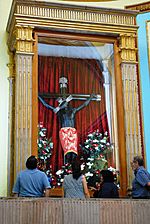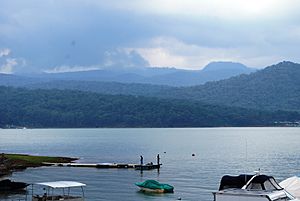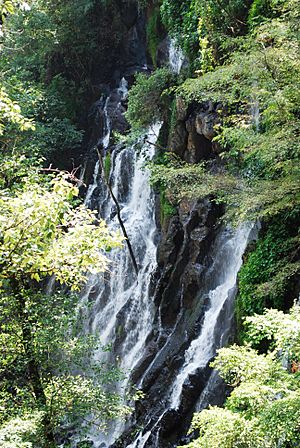Valle de Bravo facts for kids
Quick facts for kids
Valle de Bravo, State of Mexico
|
|
|---|---|
|
Municipality
|
|
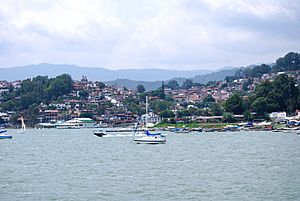
Panorama of the town from the lake
|
|
| Country | |
| State | |
| Municipal Seat | Valle de Bravo |
| Town Founded | 1530 |
| Elevation | 1,850 m (6,070 ft) |
| Population
(2020)
|
|
| • Total | 61,590 |
| • Demonym | Vallesano |
| Time zone | UTC-6 (Central Standard Time) |
| • Summer (DST) | UTC-5 (Central Daylight Time) |
| Postal code |
51200
|
| Website | valledebravo.gob.mx |
Valle de Bravo is a beautiful town in the State of Mexico, Mexico. It's one of 125 municipalities in the state. The town itself is the biggest part of the municipality. It sits right on the edge of Lake Avándaro.
Valle de Bravo is about 156 kilometers (97 miles) southwest of Mexico City. It takes about two hours to drive there. This makes it a very popular spot for people from Mexico City to visit on weekends.
The town has had many names over time. These include San Francisco del Valle de Temascaltepec and Villa del Valle. People often just called it "El Valle" (The Valley). The name "de Bravo" was added later to honor Nicolás Bravo. He was a hero who fought in the Mexican–American War. The town's Coat of arms even shows a temazcal, which is a type of sweat lodge. This is a nod to its original name.
In 1971, Valle de Bravo was called a typical city. In 2005, it became a Pueblo Mágico (Magical Town). This means it's recognized for its beauty and cultural importance. The town is famous for tourism. It once hosted a big car racing event called Circuito Avandaro. It also had a huge rock music festival called Festival de rock y Ruedas.
Exploring Valle de Bravo Town
A Look at the Town's History
The first people to live in this area were the Matlatzinca. They settled in places like Santa Maria Ahuacatlán. Between 1474 and 1479, the Aztec ruler Axayacatl took control of the region. This made it the newest part of the Aztec Empire.
After the Spanish took over Tenochtitlan, they came to this area. Andrés de Tapia and Gonzalo de Sandoval led these efforts. Then, religious groups like the Dominicans and Augustinians arrived. Around 1530, a Franciscan friar named Gregorio Jiménez de la Cuenca started a community here. It was called "El Pino."
Later, between 1607 and 1615, a Franciscan church and living area were built. The town that grew around it was first called San Franciscano del Valle de Temascaltepec. The town faced many challenges during the Mexican War of Independence. There was also a small rebellion in 1834. A man named Carlos Guadalupe Tepixtoco Abad tried to bring back the Aztec empire. But most people thought it was a silly idea, and it ended quickly.
Valle de Bravo became a town in 1842 and a city in 1878. In the early 1900s, Professor G. Velázquez wrote a poem about the area's beauty. During the Mexican Revolution, soldiers from the Zapatista movement also came through the town.
The landscape of Valle de Bravo changed a lot in the 20th century. In 1937, plans began for a power plant called Ixtapantongo. It was later named the "Miguel Alemán" hydroelectric system. Construction started in 1938 and finished in 1947. A dam was built, which flooded 2,900 hectares of land. This created the large lake you see today. The lake stretches all the way to the state of Michoacán. This power plant creates a lot of electricity. It also helps supply water to Mexico City.
The town is on a small flat area at the base of several hills. These hills are right next to the lake. In the 1960s, Valle de Bravo became famous for its car racing event. This was called Circuito Avandaro. It stopped in 1969 after a sad accident. On September 11-12, 1971, Valle de Bravo became like the "Mexican Woodstock." Between 200,000 and 300,000 young people came for the huge Festival de rock y ruedas Avandaro. This festival was held in the nearby village of Tenantongo.
The lake is actually formed by several dams. These include Valle, Tilostoc, and Colorines. When the lake was created, many fancy resorts were built. These include hotels, golf clubs, and sailing clubs.
How the Town Makes Money
The main way Valle de Bravo makes money is through tourism. It's a very popular place for weekend trips. Many visitors come from Mexico City and Toluca. During holidays like New Year's Eve and Semana Santa, the town gets very busy. It's a good idea to book a place to stay early if you plan to visit then.
Other fun events happen every year. The Festival Vallesano in March has sports, horseback riding, and art shows. There are also food tastings and music. But the biggest event is the Festival de las Almas (Festival of the Souls). This cultural festival happens every year in late September or early October. The 2007 festival brought in a lot of money. It had 8 days of fun with 151 events. These included movies, dance, art shows, music, and plays. There were also special altars for Day of the Dead. This festival has grown to include other towns too. It has featured artists from many countries. Around 160,000 to 170,000 people attend this event.
Fun Places to Visit in Valle de Bravo
Temple of Santa María Ahuacatlán
The Temple of Santa María Ahuacatlán started as a small chapel in 1864. It is now a church and is still being built. The main altar has a special Black Christ statue that people still worship. Inside, you can see very large paintings by an English artist named Phillippa. These paintings show stories from Mazahua legends and the Black Christ.
Parish of Saint Francis of Asisi
The Parish of Saint Francis of Asisi used to have two big sections. One was for the Spanish people and one for the local people. Only a few things from the 1600s are still there. These include the baptismal font and a carving of Saint Francis. Newer parts of the church have murals and Italian oil paintings. The main bell was made during the Mexican Revolution. The biggest section of the church was built in the 1950s. Everyone in town helped with this project. It was finally finished in 1994.
Casa de la Cultura
The Casa de la Cultura (House of Culture) is by the lake. It offers classes in things like aerobics, music, and painting for kids and adults. It also hosts talks about natural medicine and art shows. The building has a library, a dance hall, a cafe, and an auditorium. The art studio of painter Ismael Ramos is also here.
Joaquín Arcadio Pagaza Museum
The Joaquín Arcadio Pagaza Museum helps keep the region's history alive. It has items that belonged to Joaquín Arcadio Pagaza, a famous person from the area. The museum shows paintings and sculptures by local and international artists. It also supports reading and writing by holding talks, showing films, and putting on plays. You can also take classes in art, music, and literature here. It has a library too.
Municipal Boardwalk and Dock
The Municipal Boardwalk and Dock is on the edge of Lake Avandaro. This is the main attraction in town. There are many restaurants on the boardwalk. Some even float next to the dock! On weekends, artists sell their work here. You can rent boats for lake trips or even horses. The lake is man-made. There are over 42 boating clubs along its shores. People enjoy sailing and water-skiing here.
Jardín Central
The Jardín Central (Central Garden) is next to the Parish of San Francisco. On Sunday afternoons, you can hear live music at the bandstand. You can also buy street food like corn, tacos, and traditional ice cream. A statue of Nicolás Bravo, who the town is named after, stands here.
Paragliding and Other Sports
One popular sport in Valle de Bravo is paragliding. The Fédération Aéronautique Internationale chose Valle to host the 2009 World Championship. Over 150 people from more than 40 countries competed. The Monarca Paragliding Open is a yearly winter competition held here. It happens in January or February. Besides paragliding, flying ultralight planes is also popular. Anyone can try it. First-time flyers go with an instructor.
Valle de Bravo was named a "Pueblo Mágico" in 2005.
The Valle de Bravo Municipality
The town of Valle de Bravo is the main part of the municipality. It oversees many smaller communities. In 2005, the total population of the municipality was 52,902 people.
Valle de Bravo became a municipality in 1852. It shares borders with other municipalities like Donato Guerra and Temascaltepec. Its total area is about 421.95 square kilometers. This municipality is part of the 7th Region of Mexico State.
The municipality is surrounded by mountains and high areas. These cover about half of the total land. They include the Sierra de Temascaltepec and Sierra de Valle de Bravos. There are also small volcanoes like "Cerro Gordo." About 30% of the area is gently sloped, and only 20% is flat land. The main river is the Río Balsas. It has smaller rivers that flow into it, like El Salto.
Valle de Bravo has a mild and humid climate. It rains during the summer, from June to September. The warmest months are May, June, July, and August. The average temperature is about 17.5 °C (63.50 °F). The lowest temperature is around 1.3 °C (34.34 °F), and the highest is 32 °C (89.60 °F).
Natural Wonders and Retreats
Just south of Valle de Bravo town is a small village called Avandaro. This is where the "Rock y Ruedas" festival took place in 1971. Nearby is the Velo de la Novia (Bride's Veil) waterfall. Here, the San Juan creek drops 35 meters into a beautiful forest. This area is now a natural park.
The Maranatha Retreat is just north of Valle de Bravo. It used to be a Carmelite convent. Now, people of all faiths can visit it. It was built in the 1860s and 1870s. Its design mixes different styles, like Byzantine and Mexican Baroque. Also to the north is the village of La Peña. It sits on a high peak above the trees. You can find old remains from the Mazahua and Matlatzinca here.
Valle de Bravo is also a winter home for the monarch butterfly. Piedra Herrada is about 25 kilometers east of town. It's a special reserve to protect the butterflies. At this sanctuary, you can rent horses and get a guide. The butterflies stay here all winter at the top of the mountain in the fir trees.
Economy and Culture in the Municipality
Outside of Valle de Bravo town, farming is still very important. Farmers grow crops like corn, beans, and potatoes. Most of these crops are for the farmers themselves. But some, like potatoes, are grown to sell. Some animals are also raised here, mostly for personal use. There is also some industry, like making ceramics, furniture, and building materials.
The Valle de Bravo area attracts over 3.7 million visitors each year. These visitors bring a lot of money to the municipality. Tourism is the most important part of the local economy. It creates 60% of the jobs in the municipality.
The municipality has communities of indigenous people. You can hear languages like Nahuatl, Matlatzinca, and Purépecha. Most people here are Catholic, but there are also Protestant Christians.
See also
 In Spanish: Valle de Bravo para niños
In Spanish: Valle de Bravo para niños


